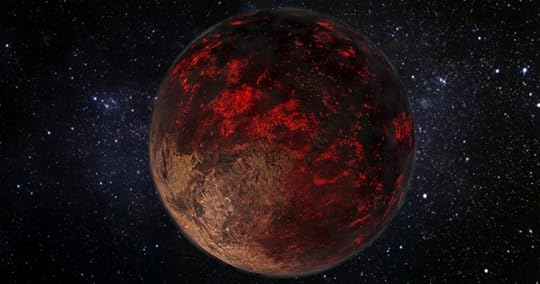Ripley Entertainment Inc.'s Blog, page 55
November 19, 2022
CARTOON 11-19-2022
November 18, 2022
How This Artist’s Work Shifts Your Perspective of the Universe
Featured in Ripley's Believe It or Not!

UK artist Luke Jerram creates surreal scenes using massive, illuminated orbs of the Earth, Mars, and the moon, measuring up to 33 feet (10 m) in diameter!
Luke has over 25 years experience as an artist, and in 2021 alone, he had 104 exhibitions in 17 different countries! Alongside his touring installations, Luke’s art can be found in over 50 permanent collections around the world including the Metropolitan Museum of Art in New York and the Wellcome Collection in London.
Moon MoodFor Luke’s captivating celestial projects, he relies on highly detailed NASA imagery. Luke then recreates the heavenly bodies at an astonishing size! For example, his 23-foot-diameter Museum of the Moon piece is at a scale of 1 to 500,000 — that means every inch of the orb is equal to almost 8 miles of the actual lunar surface!

“Museum of the Moon” by Luke Jerram at St Wulfram’s Church in England. Editorial credit: Carla Isabel A Nascimento / Shutterstock.com
The statement at the exhibit reads: “Throughout history the moon has inspired artists, poets, scientists, writers, and musicians the world over. The ethereal blue light cast by a full moon, the delicate crescent following the setting sun, or the mysterious dark side of the moon has evoked passion and exploration. Different cultures around the world have their own historical, cultural, scientific and religious relationships to the moon.”
You could say the moon was Luke’s muse from which he was able to craft a mind-blowing project that continues to captivate audiences today due to its sheer size and fabulous detail.
Celestial CreationsWhy only shoot for the moon? Luke has also taken the Earth under his wing in a similar project creating giant Earth replicas! With his Earth orbs, Luke hopes to provide his audience with the “overview effect” experienced by astronauts, which instills people with “a profound understanding of the interconnection of all life, and a renewed sense of responsibility for taking care of the environment.”

“Floating Earth” by Luke Jerram at Pennington Flash Country Park in England. Editorial credit: Wirestock Creators / Shutterstock.com
Believe It or Not!, if you stand about 690 feet away from Luke’s piece titled Gaia, it appears the same size as it would if you were looking at the real thing from the surface of the moon. Talk about an out-of-this-world experience!
Escape the Ordinary With Ripley’s Latest Book!Find this story and more inside Ripley’s all-new book! Escape the Ordinary‘s 256 pages spark curiosity, challenge perception, celebrate differences, and curate a sense of wonder for the weird world around us! Available now on Amazon and at most major retailers.
SAY “NO” TO NORMAL Ripley’s Believe It or Not! Escape the Ordinary transports readers of all ages to a world beyond imagination — where truth is always stranger than fiction! Every turn of the page reveals all-new and all-true stories from around the globe. Filled with stunning photography and engaging content, this book is every curious reader’s ticket to Escape the Ordinary.Source: How This Artist’s Work Shifts Your Perspective of the Universe
CARTOON 11-18-2022
November 17, 2022
The Mysterious and Dark Origins of 10 Classic Nursery Rhymes
Featured in Ripley's Believe It or Not!

Nursery rhymes are among the most memorable aspects of childhood. Early exposure to them helps children develop budding literacy. In fact, early childhood educators have discovered that kids who learn eight nursery rhymes by the age of four rank among the best readers in their classrooms. These word plays spark interest in the patterns and rhythms of language, boost vocabulary, and help kids learn to speak and listen.
Because these linguistic sound bites are geared toward children, it’s easy to assume they’re inherently wholesome — but a deeper dive reveals dark and mysterious origins for many. Keep reading for the lowdown on ten classic nursery rhymes that aren’t so kid friendly.
1. “Here We Go Round the Mulberry Bush”“Here We Go Round the Mulberry Bush” evokes childhood nostalgia and longing for simpler times. First published in 1840, it also has a surprising origin story. According to historian R.S. Duncan, the inspiration for the mulberry bush dates back more than 400 years. It was a tree that female inmates at Wakefield Prison exercised around. Yet, other scholars argue the story refers to Great Britain’s attempt to launch a silk industry by cultivating domestic silkworms (apparently, they eat mulberries). While the endeavor failed, the nursery rhyme stuck.
2. “Mary, Mary, Quite Contrary”“Mary, Mary, Quite Contrary” first appeared in Tommy Thumb’s Pretty Song Book in 1744. Since that time, people have argued about who the Mary in the song was. The darkest interpretation contends that the rhyme refers to the Catholic monarch, Mary I of England (a.k.a. Bloody Mary). They say the “garden” in the verse is England, and the contrariness mentioned in the song alludes to her bloody persecution of Protestants. As for the “silver bells” and “cockle shells?” They were torture devices used by Queen Mary’s executioners on her Protestant subjects.

Mary I of England (a.k.a. Bloody Mary).
3. “Humpty Dumpty”When you hear the name “Humpty Dumpty,” a whimsical egg-shaped character sitting on a wall likely comes to mind. But this nursery rhyme is borrowed straight from military history. As it turns out, Humpty Dumpty was a gigantic siege cannon! Royalists employed it during the English Civil War in 1648. They set the cannon up at the top of the St. Mary-at-the-Walls church tower, where it remained until enemy forces blew up the building and Humpty took his infamous fall.
4. “Georgie Porgie”Most historians agree that the classic nursery rhyme “Georgie Porgie” is about Prince Regent George IV of Britain. Ridiculed for his hefty weight (and 50-inch waist), he had a reputation for lusting after food and women. (Reportedly, he left a string of illegitimate children behind.) Hence the references to pudding, pie, and making the girls cry,

Prince Regent George IV of Britain.
5. “Baa Baa Black Sheep”In 1272, crusaders returned to England from the Holy Land. Along the way, they racked up quite a bill, so King Edward I imposed new taxes on Britain’s wool industry to rake in extra revenue. These tax requirements were immortalized in “Baa Baa Black Sheep’s” allotment of bags of wool to various parties, including the master.
6. “Jack and Jill”Everyone knows the story of Jack and Jill, and you probably already sense it’s a dark tale. After all, Jack breaks his crown. But what about Jill tumbling after? Historians say the story commemorates a love affair between an unmarried couple who regularly met on a hill for romantic trysts. According to legend, Jill became pregnant, but Jack died just before the birth of their child. (He either fell from the hill or got knocked in the head by a falling rock.) In turn, Jill died in childbirth, “tumbling after” her clandestine lover.
7. “Pop Goes the Weasel”Most people are familiar with the nursery rhyme “Pop Goes the Weasel,” although trying to make sense of the lyrics can prove challenging. That’s because slang has changed dramatically over the centuries. Once upon a time, people called a winter coat a “weasel,” and the act of pawning something was known as “popping.” In other words, the song’s about making ends meet by pawning a bare necessity.
8. “Three Blind Mice”Queen Mary I of England influenced more than one nursery rhyme. “Three Blind Mice” refers to her order to have three Protestant bishops viciously tortured (possibly including blinding) and burned to death at the stake. This violent episode is corroborated by the original version of the words, which includes the grisly phrase, “She scraped off the entrails and licked the knife.” Talk about dark!

You may be surprised to learn that the rhyme “Old Mother Hubbard” has nothing to do with a matronly woman or a dog searching for a bone. Instead, “Old Mother” refers to Cardinal Wolsey, an English clergyman and close ally of King Henry VIII of England. Wolsey attempted to ascertain an annulment for Henry from his first wife, Catherine of Aragon, so the king could marry Anne Boleyn. But Wolsey found the cupboard (the Catholic Church) bare. Unable to secure an annulment for Henry VIII, Wolsey lost his status as a favorite of the king. That’s some weighty stuff for a children’s tale!
10. “Ladybird, Ladybird”The children’s classic “Ladybird, Ladybird” remains a staple for small children. But the verses prove somewhat alarming and with good reason. The rhyme states:
“Ladybird, Ladybird, fly away home
Your house is on fire and your children are gone,
All except one called Anne
For she has crept under the frying pan.”

Credit: Merle d’Aubigné, Jean Henri Via Wikimedia Commons.
While the words sound pretty awful as-is, the historical interpretation heaps on more layers of creepiness. You see, Ladybird was another name for the Virgin Mary and, by extension, Catholics. During the English Reformation, they faced heavy penalties for practicing their religion, including torture and death. As a result, they had to attend masses in secret and often outdoors, hence the “children are gone” reference. Moreover, the fire may allude to Catholic priests mercilessly burned at the stake.
By Engrid Barnett, contributor for Ripleys.com
EXPLORE THE ODD IN PERSON! Discover hundreds of strange and unusual artifacts and get hands-on with unbelievable interactives when you visit a Ripley’s Odditorium!Source: The Mysterious and Dark Origins of 10 Classic Nursery Rhymes
CARTOON 11-17-2022
November 16, 2022
The City Built Atop a Crater and Riddled with Diamonds
Featured in Ripley's Believe It or Not!

They say diamonds are forever and Believe It or Not!, there’s a town in Germany that’s loaded with them thanks to an ancient meteorite impact! Surprisingly, the area containing the diamonds isn’t remote, and you don’t need a treasure map to find them because, well, they’re everywhere! Keep reading to learn more about this gem-riddled city.
The Way the Cookie CrumblesThe Bavarian town of Nördlingen, Germany, sits atop a massive meteorite crater. The town’s first inhabitants settled at the site in 898 A.D., and by the Middle Ages, townspeople constructed a wall around the city to protect it. Believe It or Not!, Nördlingen is only one of three towns in Germany with completely intact medieval city walls!

Example of a rampart crater via Wikimedia Commons.
The specific crater by which the town of Nördlingen sits atop is referred to as a rampart crater. A rampart crater is when the impact zone of an asteroid shoots debris out from the site of impact. The debris from the asteroid becomes fluidized and surrounds the impact site in what looks like a shelf and is known as the rampart.
Diamonds DancingThe meteor’s initial impact created suevite, a rough-grained stone containing crystal, glass, and diamonds. The city’s church, constructed from suevite, contains about 5,000 carats worth of diamonds, and researchers estimate that the entire townsite is embedded with 72,000 tons of tiny diamonds!
However, there is one caveat: the diamonds are far too small to be of great value.

Aerial view of Nördlingen, Germany, and the surrounding walls.
Escape the Ordinary With Ripley’s Latest Book!Find this story and more inside Ripley’s all-new book! Escape the Ordinary‘s 256 pages spark curiosity, challenge perception, celebrate differences, and curate a sense of wonder for the weird world around us! Available now on Amazon and at most major retailers.
SAY “NO” TO NORMAL Ripley’s Believe It or Not! Escape the Ordinary transports readers of all ages to a world beyond imagination — where truth is always stranger than fiction! Every turn of the page reveals all-new and all-true stories from around the globe. Filled with stunning photography and engaging content, this book is every curious reader’s ticket to Escape the Ordinary.Source: The City Built Atop a Crater and Riddled with Diamonds
What Happens to Your Body When You’re Struck by Lightning
Featured in Ripley's Believe It or Not!

Lightning strikes on humans are rare, but they can wreak havoc on the body. Between 2006 and 2021, 444 people died from lightning strikes in the United States, according to the CDC. Typically, victims are those who are participating in outdoor activities or working outside.
Shock ValueAmong other problems, being struck by lightning can cause eyesight or hearing issues, Dr. David Claypool, a staff physician at the Mayo Clinic in Rochester, Minnesota, told AccuWeather. The loud clap of thunder and bright flash from the lightning can rupture eardrums or temporarily blind a person.
Even worse, a lightning strike can cause a cardiac arrest, which stops the body from circulating blood and injures the brain and nervous system. It can also cause respiratory arrest, preventing a victim from breathing. This can lead to brain hemorrhages and strokes.

A Lichtenberg figure that resembles a lightning burn.
While most lightning strikes are not deadly, they can cause long-term health issues. Aside from internal injuries, lightning strikes can burn the body. Some of these burns resemble Lichtenberg figures, which are wavy lines or skin lesions that look like ferns.
Other long-term effects can include seizures, muscle spasms, memory loss, and cataracts from the bright flash. Everything but the cataracts can also be attributed to brain injuries, according to Claypool. Other side effects include mood swings, chronic pain, and even personality changes. Believe It or Not!, there’s one case in which a lightning strike gave a man “superpowers.”
Flash of InspirationIn 1994, Tony Cicoria MD, 42, was struck by lightning while in a public phone booth. A nearby nurse provided medical attention after he went unconscious. He experienced some memory issues, and then something extraordinary occurred, according to Psychology Today. Tony taught himself how to play the piano and started composing. Before long, he quit being a surgeon and became a professional classical musician!
Striking ScienceA lightning strike lasts just 0.01 to 0.1 seconds, but it can contain a whopping 10 million volts of energy, according to Atrium Health. Compare that to a high-voltage power line (100,000 volts) or an electrical outlet in your house (110 volts). The temperature of a lightning bolt is 30,000 degrees on the Kelvin scale, which is five times hotter than the sun’s surface.
Most electricity from lightning dissipates over the skin instead of penetrating it. This “flashover” can do indirect damage by singeing clothing, vaporizing sweat, and making metal objects such as keys and jewelry burning hot (so much so that they can brand skin). Sometimes lightning can literally blow a victim’s shoes and socks off, according to The Independent.
How to Survive a Lightning Strike pic.twitter.com/MtrsqkkezP
— SURVlVAL_TlPS (@tipsNmotivation) November 12, 2022
The good news is that the odds of being hit by lightning are 1 in 12,000, and there’s a 90-percent survival rate. To avoid being hit by lightning during a storm, it’s best to seek shelter inside a building or vehicle. Avoid taking a shower, stay away from sinks, and do not use a landline telephone during thunderstorms because lightning can travel through plumbing and electrical wiring.
By Noelle Talmon, contributor for Ripleys.com
EXPLORE THE ODD IN PERSON! Discover hundreds of strange and unusual artifacts and get hands-on with unbelievable interactives when you visit a Ripley’s Odditorium!Source: What Happens to Your Body When You’re Struck by Lightning
CARTOON 11-16-2022
November 15, 2022
Volcanic Activity on the Moon? It’s More Recent than You Think
Featured in Ripley's Believe It or Not!

Billions of years may sound like a long time to most people, but when it comes to scientific research and more specifically, geology, it’s all relative. This may explain why scientists are going wild about a sampling of lunar rock recently brought back from the moon. They reveal a far more dynamic history of volcanism than ever previously imagined. As a result, these findings are rewriting the history of Earth’s loyal satellite.
Surprisingly, the volcanic activity continued even after the moon’s mantle started to cool. While this fact appears counterintuitive on its surface, geologists have come up with some fascinating explanations based on the latest space rock data.
Keep reading to learn about the moon’s wild geological past and what it’s teaching us about outer space.
Lunar Samples Tell a New Story About the MoonIn December 2020, China’s Chang’e-5 rover traveled to the near side of the moon to sample rocks on the lunar surface. These rocks were brought back to Earth carefully sealed in airtight capsules for study devoid of contamination. The stones found their way to the China Academy of Sciences (CAS), where they underwent extensive analysis. What the scientists discovered after a preliminary study of the rocks sent their jaws to the floor.
The rocks contained mineral signatures showing that volcanoes were erupting on the moon approximately one billion years more recently than previously imagined. This represents a radical departure from moon rocks previously studied. (Those specimens were derived during the Apollo missions and had pointed toward an older record of lunar volcanism.) Today’s researchers have published these findings in the Science Advances journal.

Elevation map of the Moon with the localisation of the landing sites of successful sample return missions and the designated landing region of Chang’e 5. Credit: Kaynouky via Wikimedia (CC BY-SA 4.0) / NASA
Staying Warm Over Billions of YearsResearchers continue to grapple with how the moon retained enough heat to host a persistently flexible and plastic mantle. Today, the moon is considered volcanically dead. This is the result of billions of years of rapid cooling, rendering the moon’s mantle almost completely solidified. Once upon a time, scientists believed the final cooling occurred two billion years ago, but this new batch of rocks has researchers rethinking everything.
One substantial unanswered question plagued the researchers as they analyzed the results of their moon rock studies. How could volcanic activity take place even after the mantle cooling set in, in a big way?
The mineral composition of the rocks analyzed provided the answer: The samples contained higher levels of titanium dioxide and calcium oxide, translating into lower melt temperatures. The first author of the study, Dr. Su Bin, notes, “We discovered that the Chang’e-5 magma was produced at similar depths but 80 degrees Celsius cooler than older Apollo magmas.”
What’s the takeaway from this discovery? This study will contribute the first explicable mechanism for late-stage lunar volcanism. The scientists involved in the study hope it will also have applications when it comes to improving our understanding of the moon’s magmatic and thermal evolutions.
By Engrid Barnett, contributor for Ripleys.com
EXPLORE THE ODD IN PERSON! Discover hundreds of strange and unusual artifacts and get hands-on with unbelievable interactives when you visit a Ripley’s Odditorium!Source: Volcanic Activity on the Moon? It’s More Recent than You Think
CARTOON 11-15-2022
Ripley Entertainment Inc.'s Blog
- Ripley Entertainment Inc.'s profile
- 52 followers









